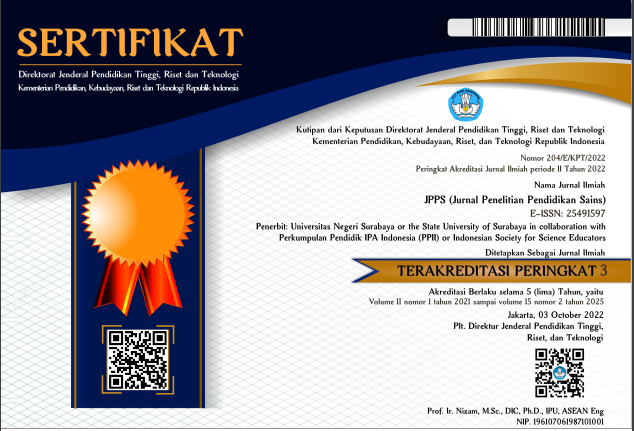VirtumFi: Development of Android-integrated Instructional Media, Teaching Materials and HOTS Questions on the Topic of Quantum Phenomena for Senior High Schools
DOI:
https://doi.org/10.26740/jpps.v13n2.p64-82Keywords:
Android , Hots Question , Quantum , Students , VirtumFiAbstract
Objective: One of the physics materials that are very important for students is quantum phenomena because it cannot be separated in everyday life. This research aims to develop a learning media "VirtumFi: Quantum Phenomena” for high school students that is feasible and practical. Method: This research is development research that used the 4D design (Define, Design, Develop, Disseminate) in the development process. Development was carried out using Adobe Animate software as an Android application development software. Results: VirtumFi has been tested valid in content and construct. In addition, VirtumFi is equipped with teaching materials and HOTS question instruments to evaluate student understanding related to Quantum phenomena. Furthermore, VirtumFi is accessed using Android so that it can be used anywhere. Novelty: The novelty that can be multiplied in this research is the VirtumFi (Virtual Laboratory Fisika) product in the form of Android with a combination of teaching material (text materials and worksheets), HOTS questions, and virtual laboratories.
Downloads
References
Ahir, K. B., Singh, K. D., Yadav, S. P., Patel, H. S., & Poyahari, C. B. (2014). Overview of validation and basic concepts of process validation. Sch. Acad. J. Pharm, 3(2), 178. https://saspublishers.com/media/articles/SAJP32-178-190.pdf
Baily, C., & Finkelstein, N. D. (2015). Teaching quantum interpretations: Revisiting the goals and practices of introductory quantum physics courses. Physical Review Special Topics-Physics Education Research, 11(2), 20124. https://doi.org/10.1103/PhysRevSTPER.11.020124
Hanif, M., Sneddon, P. H., Al-Ahmadi, F. M., & Reid, N. (2008). The perceptions, views and opinions of university students about physics learning during undergraduate laboratory work. European Journal of Physics, 30(1), 85. https://doi.org/10.1088/0143-0807/30/1/009
Huseby, A., & Bungum, B. (2019). Observation in quantum physics: Challenges for upper secondary physics students in discussing electrons as waves. Physics Education, 54(6), 65002. https://doi.org/10.1088/1361-6552/ab3694
Kemenristekdikti. (2017, April). Smartphone Rakyat Indonesia. (Online). Retrieved from ristekdikti: https://www.ristekdikti.go.id.
Krijtenburg-Lewerissa, K., Pol, H. J., Brinkman, A., & Van Joolingen, W. R. (2017). Insights into teaching quantum mechanics in secondary and lower undergraduate education. Physical Review Physics Education Research, 13(1), 10109. https://doi.org/10.1103/PhysRevPhysEducRes.13.010109
Liu, Y., Ma, Y., Xiao, X., Xie, T., & Liu, X. (2023). LegoDroid: flexible Android app decomposition and instant installation. Science China Information Sciences, 66(4), 142103. https://doi.org/10.1007/s11432-021-3528-7
Mahmudah, R., Zulirfan, Z., & Rahmad, M. (2022). Analysis of physics learning difficulties in the topic of quantum phenomena of madrasah aliyah students in indragiri hulu. Journal of Physics: Conference Series, 2309(1), 12089. https://doi.org/10.1088/1742-6596/2309/1/012089
Marshman, E., & Singh, C. (2015). Framework for understanding the patterns of student difficulties in quantum mechanics. Physical Review Special Topics-Physics Education Research, 11(2), 20119. https://doi.org/10.1103/PhysRevSTPER.11.020119
Montagnani, S., Stefanel, A., Chiofalo, M. L. M., Santi, L., & Michelini, M. (2023). An experiential program on the foundations of quantum mechanics for final-year high-school students. Physics Education, 58(3), 35003. https://doi.org/10.1088/1361-6552/acb5da
Pagels, H. R. (2012). The cosmic code: Quantum physics as the language of nature. Courier Corporation. ISBN-13: 978-0-48648506-5
Puspendik. (2020, April). Laporan hasil ujian nasional, persentase siswa menjawab benar. (Online) https://hasilun.puspendik.kemdikbud.go.id/#2019!sma!daya_serap!05&02&999!a&04&T&T&1&!1!&
Stadermann, H. K. E., van den Berg, E., & Goedhart, M. J. (2019). Analysis of secondary school quantum physics curricula of 15 different countries: Different perspectives on a challenging topic. Physical Review Physics Education Research, 15(1), 10130. https://doi.org/10.1103/PhysRevPhysEducRes.15.010130
Sumintono, B., & Widhiarso, W. (2015). Aplikasi pemodelan rasch pada assessment pendidikan. Trim komunikata.
Team, A. (2018). Potret zaman now pengguna & perilaku interet Indonesia. Buletin APJII Edisi-23.
Thiagarajan, S. (1974). Instructional development for training teachers of exceptional children: A sourcebook.
Wahyudi, A. (2015). Indonesia, raksasa teknologi digital Asia. Diakses Dari Https://Tempo.Co/Read/Kolom/2015/10/02/2310/Indonesia-Raksasateknologi-Digital-Asia
Downloads
Published
How to Cite
Issue
Section
License
Copyright (c) 2024 JPPS (Jurnal Penelitian Pendidikan Sains)

This work is licensed under a Creative Commons Attribution-ShareAlike 4.0 International License.
 Abstract views: 257
,
Abstract views: 257
, PDF Downloads: 420
PDF Downloads: 420












